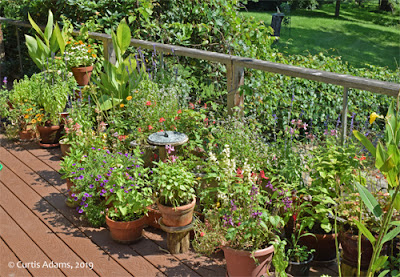 |
| Here's about half of my potted plants that I do each spring. |
I hate to throw out used potting soil. I have about 30-40 pots in various sizes. If I were to change out the soil every year I'm looking at buying 150-200 quarts of new soil each time. Then I would also need to get rid of the used stuff. In many cases potting soil can be reused for two or three seasons with a little refresher. Here are three things you can do with used potting soil.
 |
| Here's whats left as the growing season ends. These will all be brought in under cover to avoid damaging the pots in freezing weather. |
Rejuvenate it: I've reused potting soil for several
years. It does degrade over time and
will benefit from being rejuvenated. The biggest
problem is when it gets too dense and no longer drains well. Can also make it more difficult for roots to
grow and it gets soggy. Old potting soil
has also lost whatever fertilizers were there at the beginning, so nutrients
will need to be added. Espoma Flower- or Plant-tone are good organic choices. Osmacote slow
release fertilizer is another good choice, though not organic.
Compost is also a good form of fertilizer, but too much, any more than one
third by volume, in the potting mix can decrease drainage and soil
aeration. Last year I tried using
alfalfa pellets stirred into the container mix where I was growing tomatoes in
pots. It gave moderate results, but I think
I needed to use a lot more or more frequent additions to get sustained results. (The NPK value for alfalfa pellets is about 3-1-2.)
To lighten up older potting soil you can mix in fresh peat moss or coir and/or pearlite.
To improve drainage some sand could also be added, but that ingredient does
not get depleted from one year to the next.
I am torn about leaving old root balls in the container mix. They slowly decompose to build organic
matter, but they also are places where the soil is denser and they may harbor some
plant pathogens. I am tending to pull
most of them out now and throw them into the compost pile. Also pick
out any bugs and weeds that you see. I've seen warnings about not growing tomatoes in the same soil two years in a row. This is due to root pathogens carring over from one year to the next. That being said, I have replanted tomatoes in the same soil and they have survived, but I would recommend following the recommendation if your tomatoes have suffered any fungal disease. If you believe your soil is infected with pathogens, or if it is loaded with weed seeds it can be pasteurized by warming it to 120 F for 30 min. This can be done by putting to soil in black
plastic bags and placing them in full sun. Note that the more soil there is in the bag the longer it will take to get up to the right temperature.
For more tips on reusing potting soil see: https://www.springpot.com/blog/reusing-potting-soil/
Use it in the garden
to lighten heavy soil. Mixing old potting soil into heavy garden soil is a pretty
effective means of adding long lasting organic matter to the soil. I've done this and even after two seasons the soil is noticeably
lighter and easier to work with. The
down side is that any viable seeds from your potted plants are now in your
vegetable garden. As a result I now have scarlet sage and
torenia scattered through the vegetable garden. Had I pasturized the soil this problem could have been avoided.
 |
| While my vegetables are planted in neat rows, volunteer seedlings are filling in all the gaps. This photo was taken in mid-July so the salvia has not yet reached full size - it gets 'worse.' |
Throw it in the
composter. This should be a no
brainer, but I had not considered it until I read about doing this
recently. Potting soil adds 'brown' material to
the composter. Since we use our composter mostly for kitchen waste (mostly 'green' or high nitrogen materials), it is in need
of 'brown' or high carbon materials to balance it out. After adding a load of old potting soil I noticed an almost immediate increase in
composter temperature. This practice also carries a risk of spreading seed
from the potted plants, but if the compost gets up to temperature (120-140F) for
several days most of those seeds will be killed (as will most plant pathogens).
Do you have any other tips for using old potting soil? I would love to hear them.





